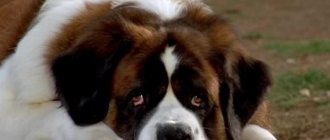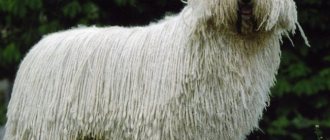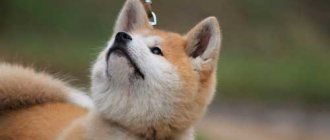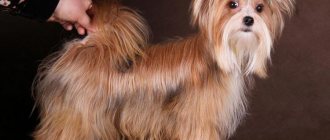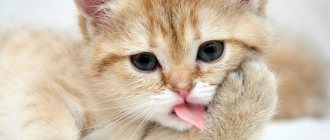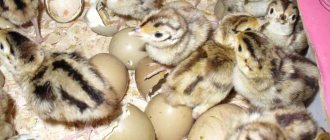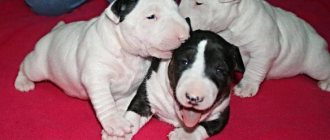Chow chow
And, first of all, we want to focus on the most famous “blue-tongued” dogs in the world - fluffy bear cubs of the chow-chow breed.
Did you know that an unusually poetic legend is associated with the color of the tongue of such dogs? Thus, many are inclined to believe that the Almighty, when creating the sky, paid attention to how the chow-chow dog became interested in this unusual process.
As a result, God allowed the curious dog to taste the sky. The brave dog bravely licked the sky and thus received an unusual color for his tongue.
Agree, a very beautiful story! Just like the dogs themselves - charming, playful and funny.
Which dog has a blue tongue?
The Chow Chow looks like a lion and a bear at the same time. At the withers it reaches 50 cm. The head of this breed is massive, the muzzle is short and very slightly pointed.
Over the course of a Chow Chow's life, the color of its tongue may change several times.
The wool is soft and pleasant to the touch.
The main distinguishing feature of the Chow Chow from other types of dogs is the unusual blue color of the tongue and mouth.
Shar Pei
As for our next blue-tongued dog, there is an unusual legend in the case of the Shar Pei. According to legend, two brothers lived in China. One was called Shar, the other was Pei. And then one day Shar stole a warm bear skin from Pei. The angry Pei rushed after his thief brother, but he was more agile.
Turning around and laughing as Pei didn’t have time to catch up, Shar stuck out his tongue at his brother. But at that very second the thief stumbled and bit his tongue. As a result, he acquired a dark blue color, and the gods, as punishment, turned his dishonest brother into a dog. And this dog received the name Shar Pei.
Eurasier
But the relatively young Eurasier breed does not yet have any legends associated with the color of the tongue. And in these dogs, on the “blueness scale,” he is in no way inferior to the first two participants in our selection.
It is believed that the Eurasier is the fruit of the “love” of the Pomeranian Spitz and Chow Chow dogs. And although not all Eurasians have a blue tongue tone, but mostly pink, Shar Pei’s “history” allows us to accept a color deviation of the tongue according to the standards.
It is noteworthy that Eurasians with a blue tongue are valued more, as they are unspokenly considered a sign of good pedigree.
In conclusion, blue spots on the tongue, as well as purple markings, can occur in breeds such as German Shepherd, Border Collie, Akita Inu, Tibetan Mastiff, Korean Jindo and Pomeranian. Moreover, spots in most cases are not a pathology, but are simply considered an acceptable norm in the color of a dog’s tongue. So if you find something similar in your pet, do not rush to panic. But you should definitely consult a veterinarian regarding new marks in the dog’s mouth cavity!
All photos and illustrations are taken from publicly available sources and belong to their authors.
Source
Dog with a blue tongue - scientific explanation
The tongue is the most multifunctional organ in a dog. It qualitatively determines the taste of food and helps digestion, helps the pet drink, lick its wounds, and also significantly cools the blood through the rapid evaporation of saliva from its surface.
The color of an animal's tongue is considered an indicator of the intensive process of blood circulation in the body. It can change its colors depending on what develops in the animal’s body (during excitement, stress, significant disruptions in the body), as well as during severe physical stress on the jaws (for example, while eating food).
In a healthy pet, the shades of the mucous membrane can vary from pale pink to dark burgundy. But there are also exceptions. There are several dog breeds that have specific characteristics. The most famous dog with a blue tongue is the Chow Chow.
Dog breeds with purple tongues
Only three breeds are born with a purple or blue tongue: the Chow Chow, Eurasier and Shar Pei. There is no exact scientific explanation for this organ pigmentation. Presumably this is due to the fact that the ancestors of these dogs lived in conditions of constant cold and lack of oxygen. The fact is that blue mucous membranes are a sign of hypoxia. But there are animals that have “reconfigured” their bodies and adapted to low temperatures and/or oxygen deficiency. Examples include polar bears, blue whales or mountain snow goats, which also have purple tongues.
Interestingly, the Chow Chow, Eurasier and Shar Pei do not necessarily have a dark tongue color throughout their lives. It’s just that for them, unlike other dog breeds, blueness of the oral cavity is not an anomaly. Puppies of these dogs can be born with blue, purple, or pink tongues. The shade will change depending on the conditions in which the pet is kept and its emotional state. It has been noted that the tongues of the Chow Chow, Eurasier and Shar Pei become more purple in winter, as well as when there is excessive excitement.
There is a relationship between the color and the color of the tongue - for example, in a black Shar Pei the organ will be darker than in red dogs
Chow chow
The Chow Chow is a dog that looks like both a bear cub and a lion. The breed is considered Chinese, but there is an opinion that it came to the Celestial Empire from Tibet, as this would explain the nature of the purple tongue (due to constant cold and hypoxia).
The Chow Chow is an excellent pet for those who value calmness, seriousness and independence in dogs.
In addition to the dark tongue, this dog has other features. For example, the Chow Chow can be easily recognized by its luxurious collar of soft wool, massive head with expressive folds, small round ears and deep-set expressive eyes.
Scientific explanations
Scientists have been studying this breed for a long time, but have not found a clear explanation for the unique color. They naturally do not trust legends and believe that chow chows appeared more than 3,000 years ago in China. This is confirmed by a figurine belonging to the Han Dynasty (206-220 BC) depicting representatives of this breed.
Mongolia is also considered as a possible homeland for these dogs, where they came from Siberia, and even before that from the Arctic. The animals lived in harsh conditions with low oxygen levels. Today, a blue tongue is considered a symptom of an acute lack of oxygen, so this version looks quite plausible.
Like puppies
Puppies are born with characteristic pink tongues, but already a month after birth the color begins to change and becomes richer every year. This is what breeders recommend paying attention to when choosing a puppy. Puppies are usually sent to a new home after 1.5 months. If by this time the blue color has not appeared, it is better to refuse the purchase. Lack of pigmentation can be a manifestation not only of insufficient purity of the breed, but also of health problems.
During life, the color changes several times: from intense blue to a light lilac-blue hue. Color is affected not only by the health and morale of the animal, but also by weather conditions. For example, in the heat or with strong excitement it becomes lighter.
Breed standard
The following points can be called the breed standard.
- Head. Flat skull with a softly defined transition to the muzzle.
- Jaws. Teeth are strong and healthy. The bite is scissor and level, and the jaw is strong.
- Nose. The wide and large nose is painted black. The muzzle is of medium length with a wide base and tapered tip. In individuals with cream-colored fur, the nose lobe may be a light shade.
- Eyes. Small, oval-shaped eyes are dark in color.
- Ears. Thick, small ears with rounded tips. They are set wide on the top of the head and tilted slightly forward, just above the eyes.
- Neck. Portly and strong neck of short length. It is set high on the body and has a slightly arched shape.
- Frame. A strong and straight back with a powerful lower back. The chest is wide and muscular with arched ribs.
- Limbs. The front ones are straight and of medium length, the rear ones are stronger and more muscular. The paws are rounded and have a cat-like structure.
- Tail. The animal seems to carry its high-set tail on itself.
- Wool. The coat is lush and thick. The hairs are coarse in texture and have a soft undercoat.
Cream coat color
Coat color
Fur colors come in the following types:
- uniform black;
- ginger;
- pale yellow;
- blue;
- cream.
Disqualifying faults
Any non-compliance with the above points of the standard is considered a disqualifying defect. Most often this concerns coat color and the structure of the skull.
Raising a pet
Due to the stubborn nature of the Chow Chow, you need to be prepared for the fact that at some periods of its life the dog will refuse to obey and test the owner’s patience. The owner must not fall for the pet's tricks. With a Chow Chow you need to be moderately strict and demanding.
Excessive gentleness towards the dog or, on the contrary, rudeness will lead to the fact that the pet will completely stop obeying and will not see the leader in the person. You can stimulate the Chow Chow's interest in a particular activity through a game or a piece of his favorite treat.
Raising a dog should begin from the first days the puppy appears in the house. Already from 2-3 months, the baby should understand where his sleeping place is. It is prohibited to place the dog next to you on the bed, since in this case the pet will feel equal to the owner.
You can only feed your dog from bowls. Never give food from the table, otherwise the chow chow will grow up to be a beggar.
Education and training
Due to their unhurried and delicate disposition, training these pets can take a long time. However, smart animals understand commands well and carry them out the first time.
The main thing for the owner is to be patient and not to rush the dog, otherwise he will lose interest in the process. The same applies to education. It is necessary to allow an independent breed to be a little independent and, just by intervening in certain situations, correct their behavior.
Note! The Chow Chow chooses its place in the house independently and changes it quite often.
You can keep your pet in an apartment
Owner reviews
The Chow Chow is a famous dog breed with a blue tongue. She has a sweet and even royal appearance, for which she received universal love. Besides the Chow Chow, the Shar Pei is a dog breed with a blue tongue. However, they are not so popular.
Judging by the reviews of the owners, the Chow Chow is an excellent pet with a wonderful character. This is an intelligent and loyal dog. Sometimes she has bouts of stubbornness, but these are temporary difficulties. In all other respects, the Chow Chow is an ideal family dog.
Source
